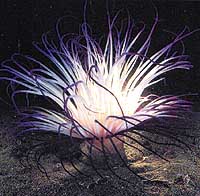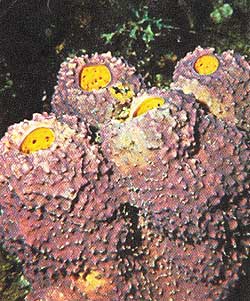by Chalerm Raksanti
The Great Bahama Bank - limestone more than 14,000 feet
think - stood above the sea after the Ice Age locked water in mammoth
glaciers. Rain gnawed holes in the porous rock. Then came the great thaw.
The ocean rose and flooded the shafts, turning them into blue gems dotting
the bank.
 The
flower-like cerianthid anemone.
The
flower-like cerianthid anemone.
Sodden with swamps and severed by wide ‘bights’,
low-lying Andros, the largest of the Bahamas Islands, sprawls for a
hundred miles beside a keep Atlantic channel that widens into the Tongue
of the Ocean. A sharp beak on the islands soggy western side broadens the
lump of land to forty miles. A few thousand islanders live along the drier
eastern edge. Reefs near the channel hold what oceanographers refer to as
‘blue holes’, whose extraordinarily strong currents set them apart
from similar formations around the globe.
 Supreme
opportunists, star fish scavenge on the ocean floor.
Supreme
opportunists, star fish scavenge on the ocean floor.
Anyone who dives into the blue holes soon begins to
wonder how they were formed. Geologists who study marine limestone
deposits can tell us something about them. The Bahamas are the above water
bits of a chain of limestone platforms or banks, stretching in a 750 mile
arc southeast of Florida. Andros, where the largest number of blue holes
are found, is the largest island of the chain. It lies on the edge of the
Great Bahama Bank with its back to the shallows, its eastern face lapped
by the Tongue of the Ocean which is a dark abyss dropping to 6,000 foot
depths.
It was during times of low water that the holes were
formed, most probably as ordinary dry land caves or sinkholes. Flowing
water followed the meandering crevices and enlarged them, finally turning
the pockets into caverns. As the last glacial period ended, once again
raising the level of the sea, the caverns flooded, forming the blue holes
of today. Submarine caves, or ‘blue holes’ have been known since
antiquity, but those of Andros differ from others in their powerful
reversing currents.
 Lavender
sponges cling to the sheer wall of the Tongue of the Ocean.
Lavender
sponges cling to the sheer wall of the Tongue of the Ocean.
The pressure of the rising tide forces sea water in the
blue holes to follow the available passages, cracks and fissures into the
spongy rock underlying Andros itself. It must flow shoreward-inland - to
escape the pressure of the incoming tide.
This deep blue branch of the Atlantic basin cuts into
the azure of the sea around it. Apollo astronauts orbiting the earth
photographed this phenomenon from 105 miles above the earth. The sheer
wall of the Tongue of the Ocean plunges more than a mile to the ocean
floor. Deep sea denizens such as the feather star inhabit caves in the
wall. Brilliant magenta thrive in deep water gloom at a depth of 270 feet,
and gorgonian polyp lined branches display bright colors. In the blackness
of caves lurks the nurse shark. Red crabs scuttle amid Neptune’s
gardens. Some of these caves are believed to go on for miles.

 The
flower-like cerianthid anemone.
The
flower-like cerianthid anemone. Supreme
opportunists, star fish scavenge on the ocean floor.
Supreme
opportunists, star fish scavenge on the ocean floor. Lavender
sponges cling to the sheer wall of the Tongue of the Ocean.
Lavender
sponges cling to the sheer wall of the Tongue of the Ocean.